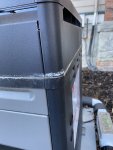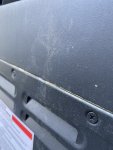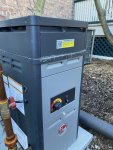White residue around top of gas pool heater.
- Thread starter magicman
- Start date
You are using an out of date browser. It may not display this or other websites correctly.
You should upgrade or use an alternative browser.
You should upgrade or use an alternative browser.
sktn77a
Gold Supporter
Do you think it’s anything to worry about? I doubt it’s a leak because it’s the only place I’m seeing it and no pool water flows there. Wondering if moisture is getting trapped in the exhaust and causing some corrosion? It’s been cold, we run it 4 hours/day to keep water temps in the 70-80 range.
- Jul 21, 2013
- 66,332
- Pool Size
- 35000
- Surface
- Plaster
- Chlorine
- Salt Water Generator
- SWG Type
- Pentair Intellichlor IC-60
Last edited:
Magic, can we see what this pool looks like. Being in Ohio makes me wonder how you keep water at those temps @4 hours a day. Is this under an enclosure??
I was initially concerned about condensation as well, but the water temp has never dropped below 72 and is usually in the mid 80s. The pool is basically a very large hot tub, so it’s small enough that the water temp is being maintained with short run times. We also have an insulated blanket so we’re not losing a ton of heat over night (believe it or not).
Since the water temperature is always above 70, we shouldn’t be in the danger zone, but could the freezing cold air be a factor and cause condensation?
I never hear sizzling (like mentioned in the post ajw22 referenced) and it’s strange that it’s around the outside edge at the very top of the heater (haha or maybe not strange, what do I know).
One thing I wondered was if this could be from rain or pool water dripping down, getting trapped in that seaand evaporating when it hits the hot heater? We have a salt water pool and the pressure release valve is very close to the heater and sometimes sprays as little water in that direction.
The heater is labeled “pool and spa” heater, so if I was using it to heat a “real” spa, wouldn’t it stand to reason that it could operate in the winter? How do people with spas keep them warm in the winter months?
A friend actually has a small fiberglass pool like ours, but it’s indoors. They keep it open year round, but their equipment is all located outside. To the best of my knowledge, it’s been working fine.
I certainly don’t want to destroy our new heater, so I appreciate the feedback and advice from people who understand the topic more than me.
I’m attaching a few pictures of the pool.
Thanks again for the help!
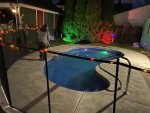
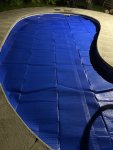
Since the water temperature is always above 70, we shouldn’t be in the danger zone, but could the freezing cold air be a factor and cause condensation?
I never hear sizzling (like mentioned in the post ajw22 referenced) and it’s strange that it’s around the outside edge at the very top of the heater (haha or maybe not strange, what do I know).
One thing I wondered was if this could be from rain or pool water dripping down, getting trapped in that seaand evaporating when it hits the hot heater? We have a salt water pool and the pressure release valve is very close to the heater and sometimes sprays as little water in that direction.
The heater is labeled “pool and spa” heater, so if I was using it to heat a “real” spa, wouldn’t it stand to reason that it could operate in the winter? How do people with spas keep them warm in the winter months?
A friend actually has a small fiberglass pool like ours, but it’s indoors. They keep it open year round, but their equipment is all located outside. To the best of my knowledge, it’s been working fine.
I certainly don’t want to destroy our new heater, so I appreciate the feedback and advice from people who understand the topic more than me.
I’m attaching a few pictures of the pool.
Thanks again for the help!


After examining things further the white residue is only the outside of the heater. If I look inside the the top of the heater I can see the back side of the seam where the white residue has accumulated and there’s nothing there. See photo attached.
Is it possible this is just some salt/residue from the pool water or rain?
How would I be able to verify we don’t have a condensation problem? I do see a little moisture on the top of the heater, but it’s my understanding the condensation issue actually happens inside on the heat exchanger.
you can see here the white residue doesn’t go under the top side of the heater. I’m pushing the metal a bit to fully expose the edge...

you can see here a
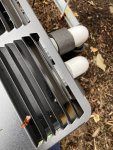
Is it possible this is just some salt/residue from the pool water or rain?
How would I be able to verify we don’t have a condensation problem? I do see a little moisture on the top of the heater, but it’s my understanding the condensation issue actually happens inside on the heat exchanger.
you can see here the white residue doesn’t go under the top side of the heater. I’m pushing the metal a bit to fully expose the edge...

you can see here a

- Jul 21, 2013
- 66,332
- Pool Size
- 35000
- Surface
- Plaster
- Chlorine
- Salt Water Generator
- SWG Type
- Pentair Intellichlor IC-60
How would I be able to verify we don’t have a condensation problem? I do see a little moisture on the top of the heater, but it’s my understanding the condensation issue actually happens inside on the heat exchanger.
Condensation happens on the outside of the heat exchanger. Condensation also occurs from the water vapor in the exhaust when the exhaust temperature is cooled below the condensation temperature. The condensation will mix with exhaust gasses and be acidic as it falls on the inside of the heater. I am not sure you will see much residue on the inside of the heater after the condensation has evaporated.
Pentair warns about operating the MasteTemp heater continuously at water temperatures below 68° F.
tstex
Silver Supporter
As long as no on has been dispensing chemicals near your house, I bet this is salt precipitating out of the condensation then drying process. Take your finger and put a small amt of the powder on your finger tip and touch it w your tongue. I bet is is salty.
When you temps' are below 65 degrees and you heat-up the water, you get condensation/vapor...then when it drys, any salts precipitate out in the form of white powder.
When you temps' are below 65 degrees and you heat-up the water, you get condensation/vapor...then when it drys, any salts precipitate out in the form of white powder.
Thread Status
Hello , This thread has been inactive for over 60 days. New postings here are unlikely to be seen or responded to by other members. For better visibility, consider Starting A New Thread.


